22 Weeds and Invasive Plants That Are Actually Delicious—Here's How to Use Them in Your Cooking
These edible plants can be used in soups, salads, teas, and more.
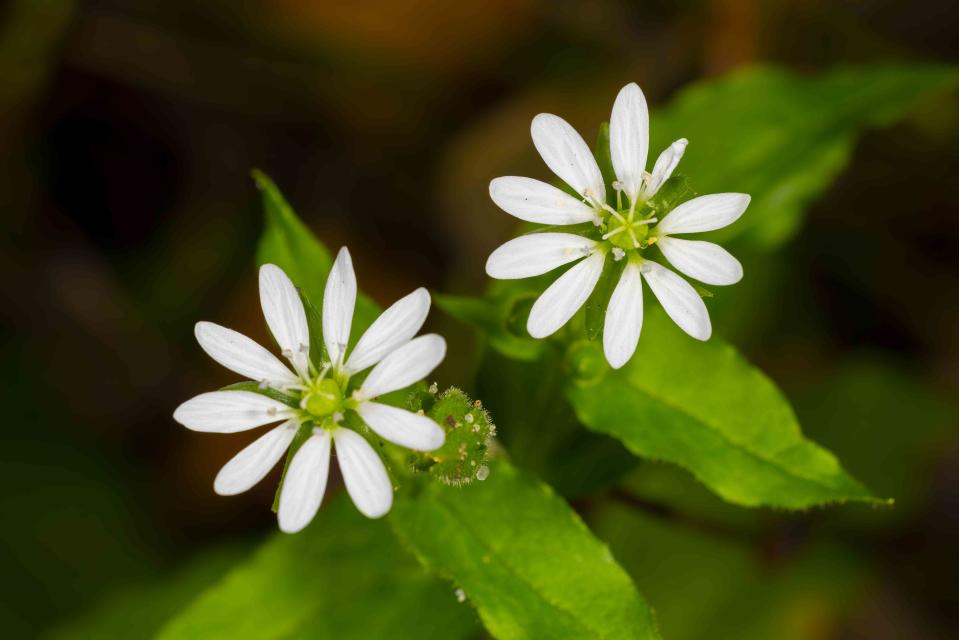
500px / Getty Images
Often appearing uninvited in your front yard and flower beds, weeds and invasive plants can be a nuisance in the landscape. And while you may not like the way they look or how they interact with the rest of your plants, many of these invasive plants are actually delicious when harvested and used in your cooking. Rather than pulling out and throwing away these plants, first check our list of edible weeds and invasive plants to see if their stems, roots, flowers, or seeds are consumable. Chances are you'll find that most of the pesky species growing in your landscape can be used in soups, stews, teas, salads, and more.
Related: 30 Common Weeds—and How to Control Them, According to Experts
Dandelion
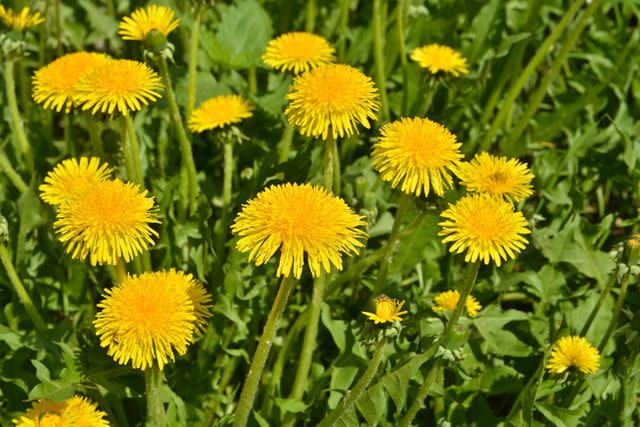
Sergunt / Getty Images
Dandelion (Taraxacum) is a very common weed. "The taproot of this plant produces a basal rosette with irregularly toothed leaves that hold a white milky juice," says Linda Langelo, horticulture specialist at Colorado State University. "The bright yellow flowers bloom in spring in the cooler parts of the season. The flowers turn into silvery white balls of fruit that have parachute-like appendages."
Every part of this weed can be eaten, from the roots to the yellow flowers. The leaves are commonly used in soups and can also be eaten raw in fresh salads. The flowers are often battered and fried, says Carrie Spoonemore, co-creator of Park Seed’s From Seed to Spoon app.
Related: How to Make a Dandelion Tonic
Lambsquarters
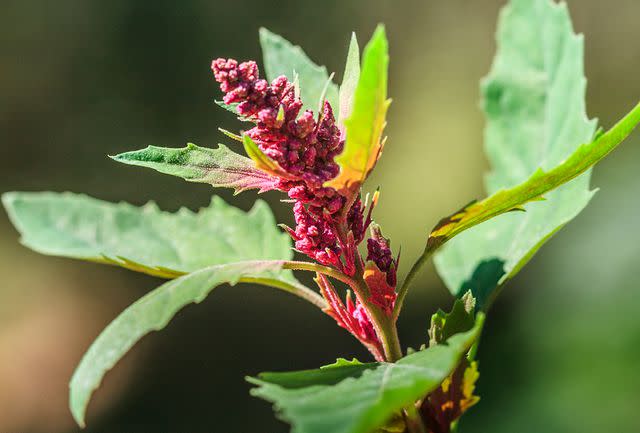
Getty Images
A weed with serrated, diamond-shaped leaves, lambsquarters (Chenopodium album) has a waxy finish coating the leaves. The fast-growing annual plant is typically found growing in landscapes during summer.
The leaves and young stems of lambsquarters are edible when tender, says expert forager Tama Matsuoka Wong, author of Into the Weeds: How to Garden Like a Forager. To use lambsquarters in the kitchen, roughly chop and sauté it, says Wong. You can also add it raw to salads.
Purslane
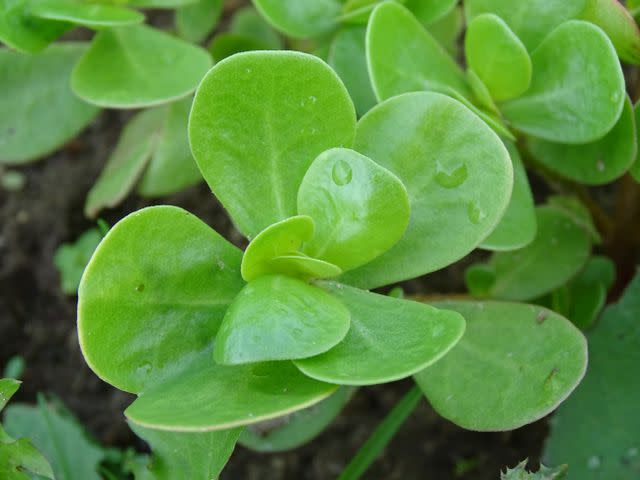
Annerieke Schuurman / Getty Images
This weed is an annual succulent with teardrop or wedge-shaped leaves that are smooth and fleshy green with red margins. Purslane (Portulaca oleracea) forms yellow flowers with five petals in the leaf axis. "The flowers can also appear individually or at the stem tips in clusters where they stay open only for a day like a daylily," says Langelo.
To forage purslane, pick the top tips only before they flower and avoid the stems, which can be mucilaginous (gelatin-like consistency), says Wong. Enjoy purslane raw by adding it to soups and salad as a crunchy garnish.
Before consuming wild plants, be sure to confirm their identification by using an official field guide or asking an expert.
Always wash before preparing, and be careful not to forage plants that have been exposed to herbicides, pesticides, or environmental pollutants.
Remember that some wild plants have medicinal properties; check with your healthcare provider to make sure there are no contraindications.
Common Quickweed
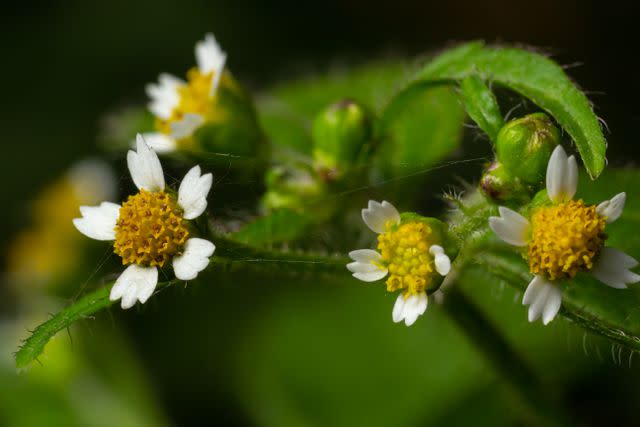
Oleg Marchak / Getty Images
Common quickweed (Galinsoga parviflora) goes by a few names, including shaggy soldier and Peruvian daisy. It can typically be found growing all summer until the last frost, says Wong. The weed forms small flowers that resemble tiny daisies.
The leaves and flowering tips of common quickweed are safe to eat. Chop and sauté the edible portions like you would a vegetable.
Chickweed
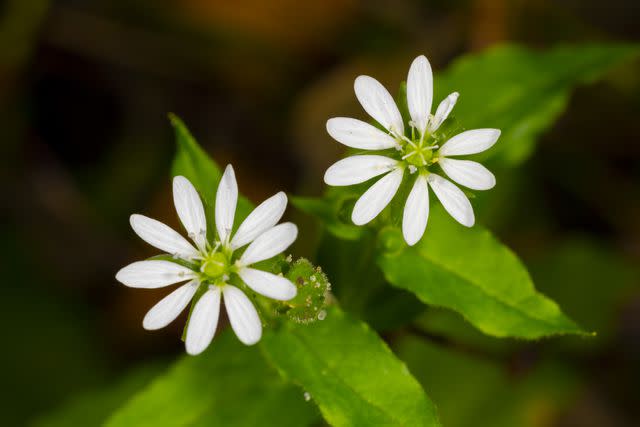
500px / Getty Images
Chickweed (Stellaria media) is an annual weed that grows in the cool season. "This plant grows low to the ground and has small star-shaped, white flowers with hairy stems," says Langelo.
The leaves, stems, and flowers of chickweed are edible. "The leaves are added raw to salads and sandwiches," says Langelo. "The leaves are also tossed into soups and stews. The stems and flowers can be used in cooked dishes."
Japanese Honeysuckle
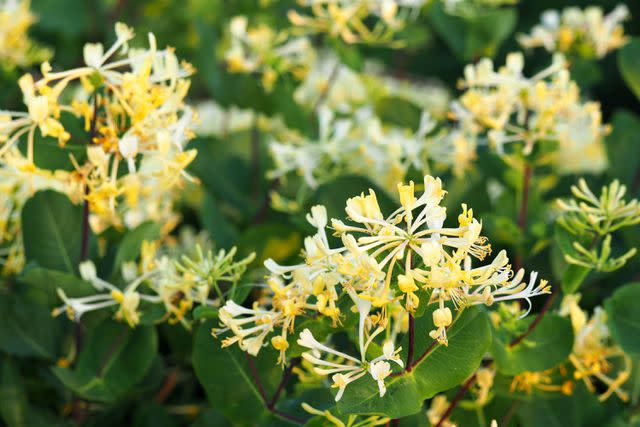
ANGHI / Getty Images
There are many honeysuckle varieties that grow across the country. "Lonicera japonica is the most fragrant of these—a vining plant with opposite, oblong, glossy leaves," says expert forager Lisa M. Rose, author of Urban Foraging: Find, Gather, and Cook 50 Wild Plants. "The flowers are white and tubular, and they form in pairs along the stem. The flower is very aromatic, similar in scent to jasmine or orange blossom, but its taste is predominantly bitter."
The flowers can be used to make teas, oils, and more. To use it in tea, pick the flowers before they open when pale green and white, says Wong. You can also use honeysuckle flowers to infuse raw honey by placing un-wilted blossoms into a jar and covering them with raw honey, says Rose. Let it infuse for a few weeks, occasionally turning the jar upside down to stir up the plant material.
Wild Fennel
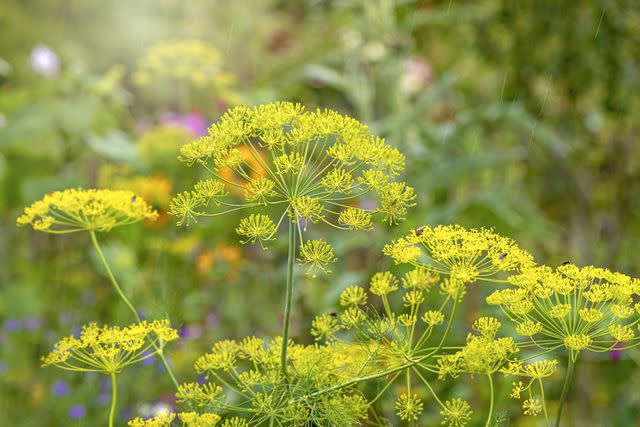
Jacky Parker Photography / Getty Images
Unlike farmed fennel, wild fennel (Foeniculum vulgare) does not create a bulb and is more aromatic. "It's invasive in mainly California but now has spread through much of North America, says Wong." The invasive plant has tall, upright stems with yellow flowers.
The fronds, green unripe seeds, and ripe seeds of wild fennel are edible and can be used as a spice, in salad, raw, and dried, says Wong.
Related: What Is Fennel Pollen—and How Should You Cook With It?
Mugwort
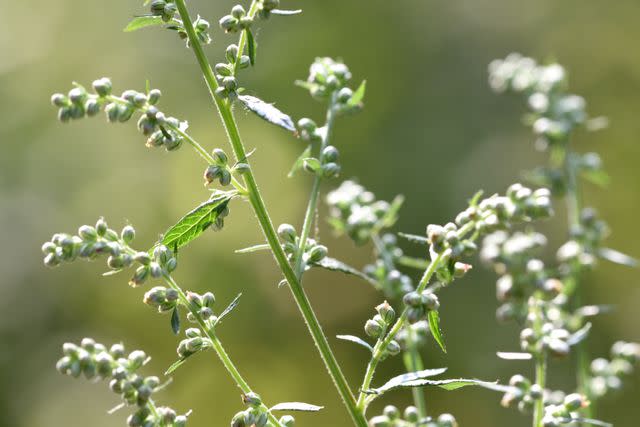
Getty Images
Mugwort (Artemisia vulgaris) is an invasive species that's native to Europe and parts of Asia and Africa. It grows during spring and is identified by its finely dissected leaves that are silvery on the underside.
The flavor of mugwort may vary depending on location—the mature plant may become very aromatic and strong flavored and bitter if it's in a very exposed location, says Wong. The young leaves of mugwort are edible and can be used in soup or tempura.
Garlic Mustard
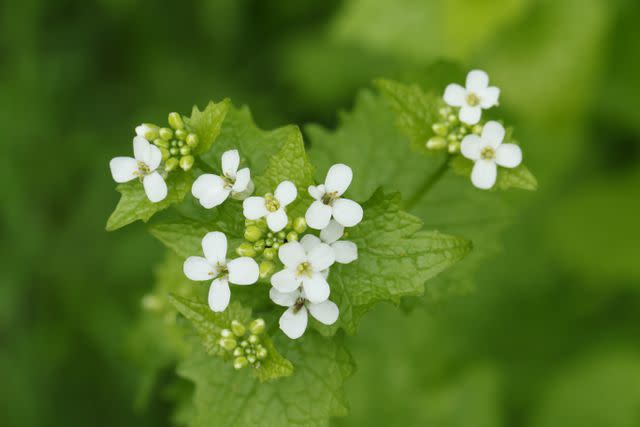
sandra standbridge / Getty Images
Garlic mustard (Alliaria petiolata) is an early spring biennial that's widespread across the forest floor and along the edges of wooded areas. "It is one of the first spring greens foragers can enjoy after a long winter," says Rose. "In urban areas, it is widely distributed in areas of disturbed soil."
In the first year, it grows as a basal rosette of green, heart-shaped leaves. In its second year, the plant sends up as many as six flower stalks with white blooms that are about 40 inches tall.
The young leaves that shoot up from the base are edible. "Cut away the fibrous stems and avoid the lowest basal leaves, which may be very bitter," says Wong. Garlic mustard is often used to make pesto.
Knotweed
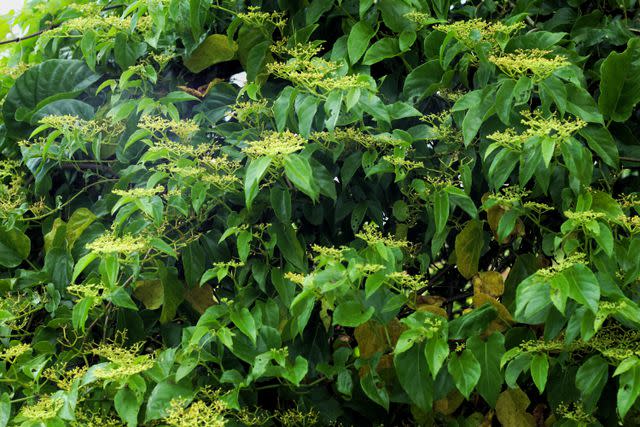
Rizky Panuntun / Getty Images
Knotweed (Fallopia japonica) is often found growing in spring along stream banks and open moist wood edges. It produces 4 to 6 feet tall, upright, hollow stems that are joined by nodes like bamboo, says Wong. From the stems, grow large oval or triangular leaves and white to green flowers.
The non-woody stems and young leaves of knotweed are edible. "Cut the stems on the round, and pickle, cook, or bake," says Wong, adding that knotweed is a great substitute for rhubarb.
Burdock
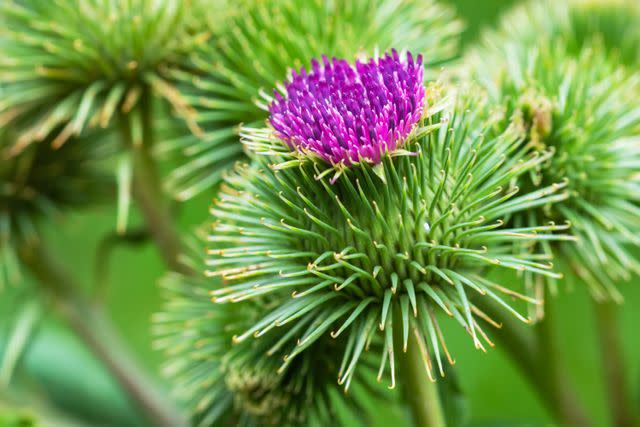
Dmytro Skrypnykov / Getty Images
Burdock (Arctium lappa) is an invasive biennial plant with heart-shaped leaves and purple flowers. It can thrive in many conditions and is not phased by poor, rocky soil or drought. "It loves the disturbed edges of fields and waste sites and is prolific in spreading seeds," says Rose. "Because burdock grows abundantly in urban and suburban areas, be sure it is free of herbicidal applications, lead, or environmental pollutants."
Burdock is completely edible, from root to seed, and is highly nutritious. "Burdock root is a mildly sweet, nourishing carbohydrate," says Rose. "It is a versatile starchy vegetable that can be eaten raw julienned in salads, or it can be mashed, roasted, and even pickled." The young, tender greens can be sautéed, included in a stir-fry, or added to soups. If you are cooking the stems, peel them as you would a fibrous rhubarb stalk, then julienne them for salads or stir-fry.
Red Clover
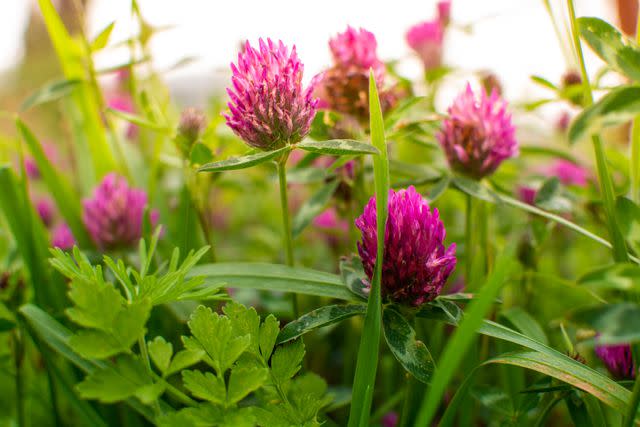
Crispin la valiente / Getty Images
Red clover (Trifolium pratense) is a low-growing ground cover that has distinctive reddish-purple flower heads and trifoliate leaves, says Spoonemore. Red clover begins to blossom during June, boasting beautiful blooms composed of nectar-filled tubular florets.
The leaves, stems, and flowers of red clover are edible. "The fresh blossoms do work well in a fritter, egg dish, or in soups and have a flavor similar to the sweet pea," says Rose. "They can also be steamed and used as a garnish or side dish with a light white fish or chicken." You can also extract red clover's flavor to use in tea, smoothies, and more by boiling the fresh or dry plant material for 20 minutes.
Chicory
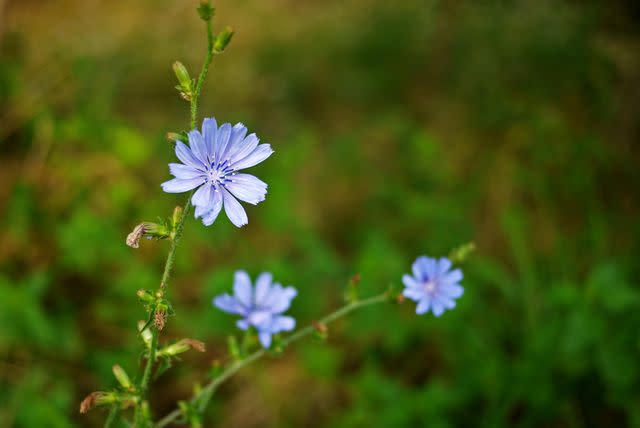
Rosmarie Wirz / Getty Images
Chicory (Cichorium intybus) is a weed that has beautiful bright blue flowers and elongated leaves with a bitter taste, says Spoonemore. The herbaceous perennial is often found growing along roadsides, railroads, and sometimes abandoned fields.
Both the leaves and roots of chicory are edible. "Chicory leaves can be used in salads or cooked as greens, while the roots can be roasted and ground as a coffee substitute," says Spoonemore.
Related: What Is Chicory Root, and Should You Try Chicory Coffee?
Plantain
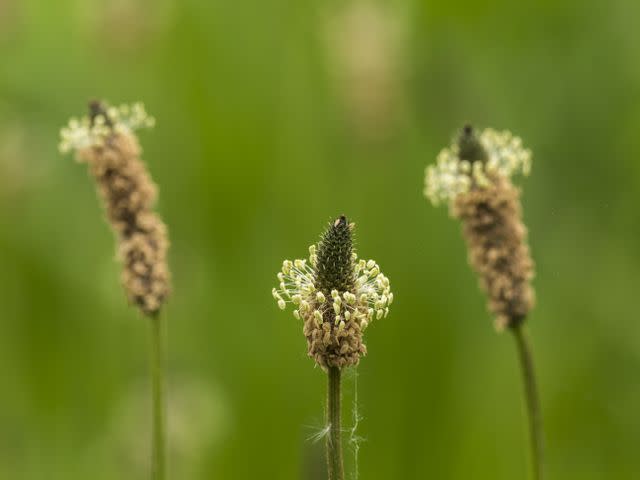
Javier Fernández Sánchez / Getty Images
Plantains (Plantago) are a perennial weed with over 200 species and all are edible. "Plantain has broad, ribbed leaves and produces small, greenish-white flowers," says Spoonemore. The leaves are slightly hairy and have a palmate vein that runs parallel to the midrib.
The leaves and seed head of plantains are edible. "Plantains are commonly eaten as a fried side dish," says Langelo. "Other uses of plantains include soups, stews, and baked dishes." The leaves can be eaten raw in early spring when they're still tender. As they mature, the leaves get tougher and the midrib and fibrous veins need to be removed before consuming, says Langelo.
Curly Dock
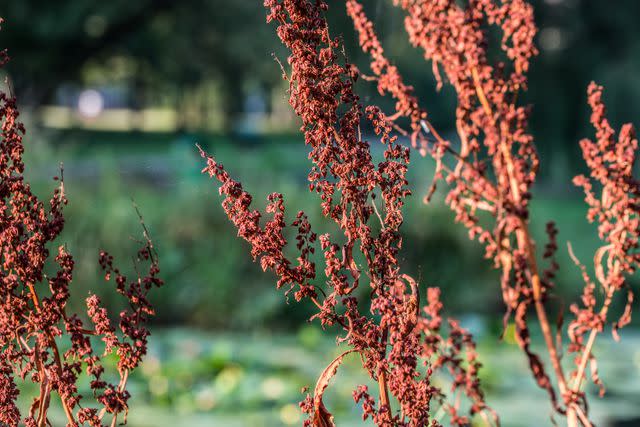
aga7ta / Getty Images
Curly dock (Rumex crispus) is a perennial weed with a thick taproot and leaves that form mostly at the base of the plant. At the top of the stems, the plant produces small green flowers that turn reddish-brown as they mature.
Pick the smallest leaves in early spring, which contain a delicious lemony flavor. The leaves should be washed before consuming and are used in salads, as a cooked vegetable, in stir-fries, egg dishes, and in soups, says Langelo. The stems are also edible and should be used before they produce flowers and are still pliable.
Goosefoot
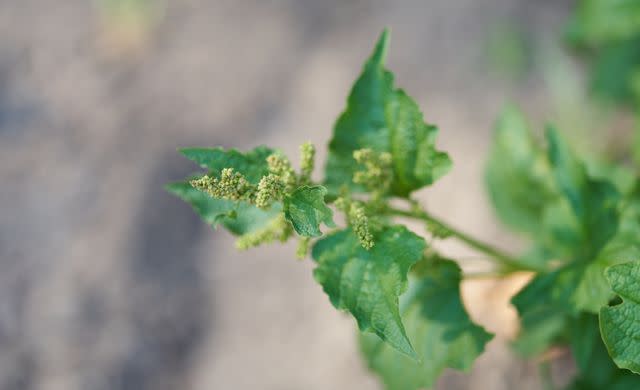
annick vanderschelden photography / Getty Images
Goosefoot (Chenopodium berlandieri) can be either an annual or perennial plant and is related to garden beet, Swiss chard, and spinach. "This plant has grey-green leaves that resemble a goosefoot, hence the name," says Langelo. "The flowers are small green with yellow flecks along the stems."
All parts of goosefoot are edible, including the leaves, stalks, flowers, and seeds. "Since this is another invasive weed be sure to harvest plants that are free of chemical sprays used to kill the plants," says Langelo. Do not consume the plant raw—it should be cooked or steamed prior to consumption. The stalks of goosefoot can be cooked and eaten as a vegetable side. The flowers can be sautéed and enjoyed like broccoli rabe.
Multiflora Rose
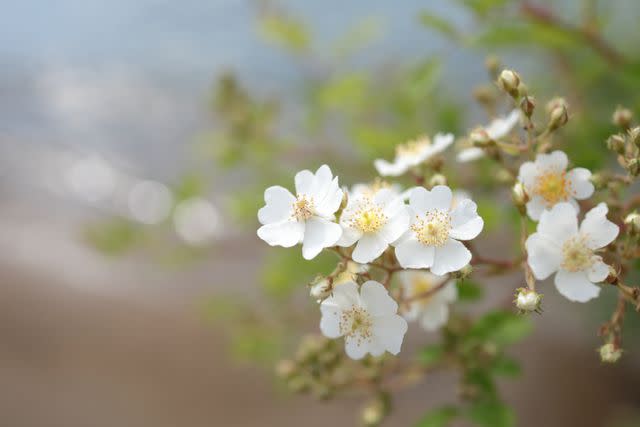
Masako Ishida / Getty Images
Multiflora Rose (Rosa multiflora) is an invasive deciduous shrub that came to the United States from Asia. "It is a rapidly growing, climbing, rambling shrub that can reach heights of 10 to 15 feet," says Langelo.
The rose hips, seeds, flowers, and leaves are edible. "Harvest rose hips after the first frost because they are sweet and soft," says Langelo. The seeds can be steeped into tea or ground up and added to meals. The leaves and flowers can be eaten raw.
Related: A Visual Guide to Edible Flowers—and How to Use Them
Blackberry
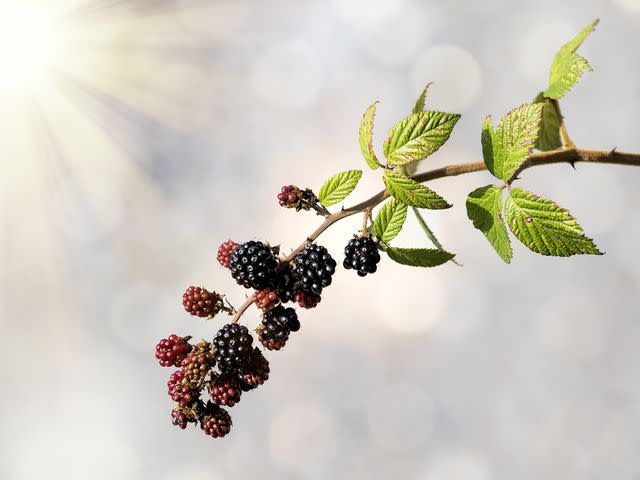
Jose A. Bernat Bacete / Getty Images
Blackberry (Rubus Species) is usually found as a large stand of plants in the sun on the edges of the woods. "A bramble of a plant reaching heights up to 5 feet, the blackberry is covered in thorns," says Rose. Its divided leaf clusters hold serrated and ovate leaflets. Blackberry blooms in late spring with white flowers that bear seedy, slightly hairy fruit that ripens into dark purple berries in late summer.
The fruit and leaves of blackberry are edible. "The plant offers an abundance of food: its leaves and roots can be used for tea, and the berry makes for delicious eating," says Rose. "The dark-berry, jammy flavor of blackberry is delicious in a variety of desserts, snacks, and preserves, including jam, chutney, and syrups for cocktails and sodas."
Related: 30 Blackberry Recipes to Make All Summer Long
Daylily
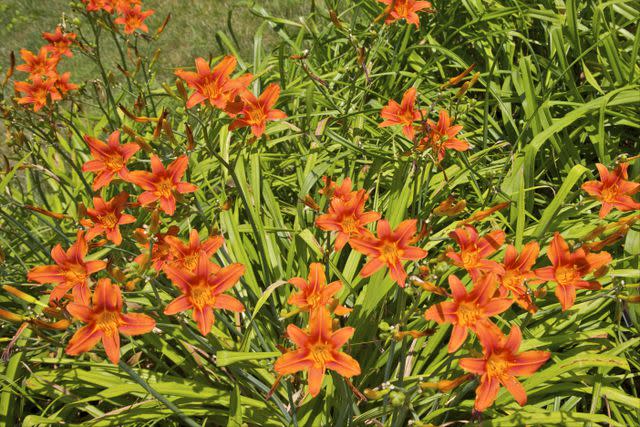
Barry Winiker / Getty Images
The common daylily (Hemerocallis fulva) is found in parks and open spaces, usually without intentional cultivation. "There are over 60,000 varieties of daylily, and not all are edible," says Rose. "Hemerocallis fulva is most chiefly identifiable by its bright orange, six-petaled flowers, which can bloom from early July into August, depending on your location."
The flowers, shoots, and tubers of common daylily are edible. "Use the early spring shoots of the daylily as cooked greens for stir-fries and frittatas," says Rose. "Edible daylily blooms are delightful to gather and look beautiful atop fresh, green summer salads." The tubers are quite substantial and can be chopped and sautéed in butter. Their crisp texture also makes them ideal for pickling.
Elder
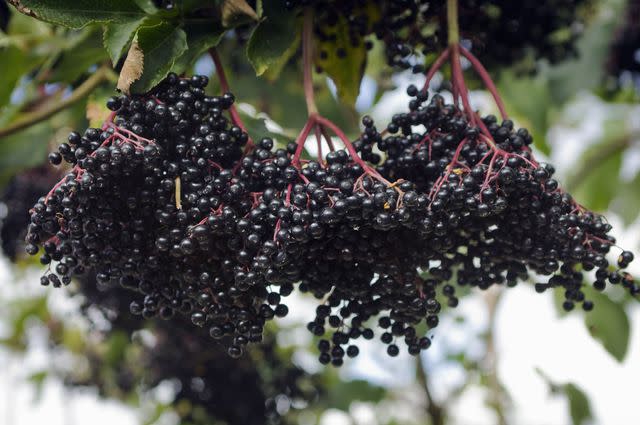
Richard Clark / Getty Images
Elder grows in hedgerows, along edges of fields, in drainage ditches, and other low-lying areas where water flows. Sambucus nigra and Sambucus canadensis are two edible varieties. "The elder is a large shrub that begins bearing clusters of fruit when it is approximately 5 feet tall," says Rose. Around midsummer, elder’s white fragrant flowers unfold, which are followed by berries in mid-to-late August.
The flowers and berries of elder are edible—but this plant should not be consumed raw. In the kitchen, elder can be used to make infused honey, tea, and syrup.
Related: How to Make Elderflower Cordial
Mulberry
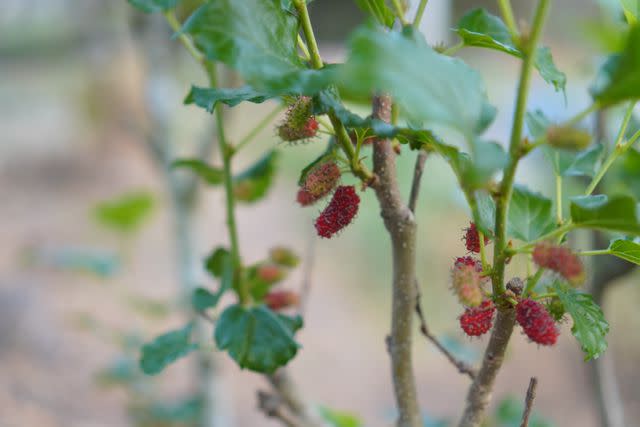
Penpak Ngamsathain / Getty Images
Mulberry is a type of tree that can grow up to 70 feet tall. "Its young bark ranges from yellowish brown to orangish brown, with scattered large white lenticels," says Rose. "Older bark is brown and ridged with an occasional glimpse of orange inner bark."
The leaves of white mulberry (Morus alba) are smooth and dark and shiny on top, while those of red mulberry (M. rubra) feel rough. Red mulberry has longer, juicier, and better tasting fruits than white, says Rose.
Mulberry isn’t very sweet or tart, and it isn’t significantly jammy. The berries are the only edible portion and can be snacked on raw or used to make jam or an infused syrup.
Nettle
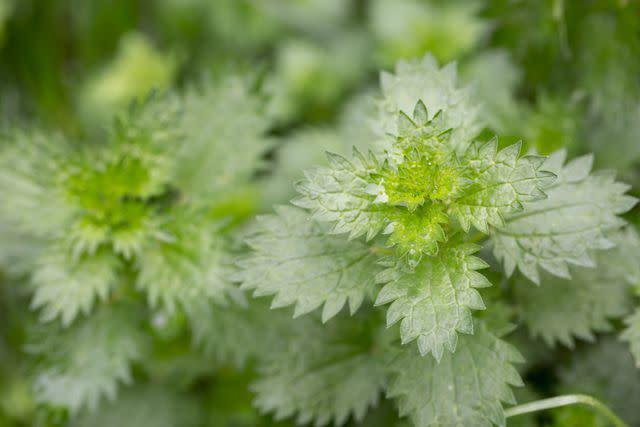
AnitaBen / Getty Images
Nettle (Urtica dioica) is a fast-growing perennial that thrives in moist ditches and along stream banks. Its toothed, dark leaves are oblong and covered in fuzzy hairs.
One of nettle’s chief identifiers is its sting, says Rose. While nettle doesn’t really have stingers or thorns, it has fine hairs filled with formic acid that break open on the skin and can cause a histamine reaction.
The effect of nettle is neutralized when the plant is cooked or dried. The leaves and stems are often added to pizzas, pastas, frittatas, or egg scrambles, says Rose. "Fresh nettles can easily replace spinach in recipes that call for greens. The dried leaves can be enjoyed year-round and added to soups and brewed as a mineral-dense, tea-like beverage."
Related: Get the Recipe for Nettle Soup
Read the original article on Martha Stewart.

